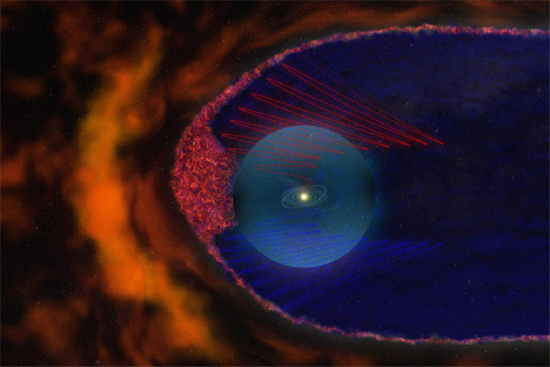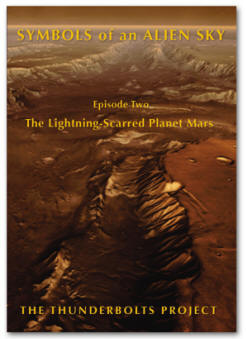|

Artist's impression of "magnetic
bubbles" surrounding the Solar
System.
Credit: NASA
Magnetic Effervescence
Jun
13, 2011
"Bubbles" of magnetic energy
are said to surround the Sun's
heliosheath.
"In all our quest of greatness,
like wanton boys, whose pastime is
their care, we follow after bubbles,
blown in the air."
--- John Webster
According to astronomer
Merav Opher of Boston University's
Voyager team: "The Voyager probes
appear to have entered a strange
realm of frothy magnetic bubbles.
This is very surprising."
Voyager 1 encountered the
heliosheath in December 2004,
followed by Voyager 2 in August
2007. It was Voyager 1 that first
detected fluctuations in the
electron count as it traveled
through the heliosphere, while
Voyager 2 made similar observations
later in 2008.
Since NASA's computer model of
the heliosphere works only if the
readings are assumed to come from
flying in and out of the
aforementioned bubbles, some means
for their creation had to be
concocted. Enter stage left, the old
tried and true, magnetic
reconnection.
As a
press release about the
discovery states, the Sun's "twisted
and wrinkled" magnetic field lines
far out in the heliosphere "bunch
up," causing them to "reconnect" and
explosively "reorganize" into long,
sausage-shaped bubbles of magnetism.
The European Space Agency's
Cluster mission recently
observed anomalous bubbles that
"grew and popped" around Earth, as
well. The magnetic interactions were
detected where Earth's magnetic
field meets the barrage of charged
particles known as the solar wind.
In the same way as the bubbles
around the Solar System are supposed
to be created, magnetic reconnection
was used to explain this case, as
well.
Earth’s magnetospheric “bubble”
is known among space plasma
physicists as a Langmuir sheath and
is part of an electrical circuit
coupled to currents flowing in the
Sun's heliosphere. Langmuir sheaths
are electrically charged double
layers of plasma, in which opposite
charges build up near each other,
creating an electric field between
them. Double layers can accelerate
ions to extreme velocities that
might easily be misinterpreted as
high temperature.
The same conditions are most
likely present where the solar
magnetosphere, or heliosphere, meets
the dissimilar charge of the
Interstellar Medium (ISM). Two
regions of dissimilar plasma will
form a Langmuir sheath between them,
which leads to a potential “bubble”
formation.
Plasma in a laboratory isolates
itself with thin walls of oppositely
charged double layers, so it is
probable that the same thing is
happening around the Sun and around
Earth. By extension, the same thing
is most likely occurring around our
galaxy, the galactic clusters, and
the superclusters. At every scale,
plasma behaves in the same way.
Proving that case will be impossible
for centuries to come, no doubt,
because there is no way to know
except by placing a Langmuir probe
into each location and measuring the
current differential.
Charged particles in motion
comprise an electric current. That
current wraps itself in a magnetic
field. As more charged particles
accelerate in the same direction the
magnetic field gets stronger. A
familiar idea to electrical
engineers, but when astronomers find
magnetism in space they are
mystified. They resort to ironic
ideas about voids with magnetic
fields frozen inside them or
so-called "magnetic reconnection."
Electric Universe advocate
Wal Thornhill wrote:
"...plasma in space forms a bubble,
known as a 'virtual cathode'.
Effectively it is the heliopause. In
plasma terms, the heliopause is not
a result of mechanical shock but is
a Langmuir plasma sheath that forms
between two plasmas of different
charge densities and energies...Such
'bubbles' are seen at all scales,
from the comas of comets to the
‘magnetospheres’ of planets and
stars."
Although no specific data is yet
forthcoming, Electric Universe
scientists assume that plasma
behaves in space the same way as it
does in the laboratory. Armed with
that insight, an electrically
sensitive mind will see what
otherwise remains invisible.
Stephen Smith
Hat tip to Jason Brown
 New
DVD New
DVD
The Lightning-Scarred
Planet Mars
A video documentary that could
change everything you thought you
knew about ancient times and
symbols. In this second episode of
Symbols of an Alien Sky, David
Talbott takes the viewer on an
odyssey across the surface of Mars.
Exploring feature after feature of
the planet, he finds that only
electric arcs could produce the
observed patterns. The high
resolution images reveal massive
channels and gouges, great mounds,
and crater chains, none finding an
explanation in traditional geology,
but all matching the scars from
electric discharge experiments in
the laboratory. (Approximately 85
minutes)
Video Selections
Order Link
|





 New
DVD
New
DVD

